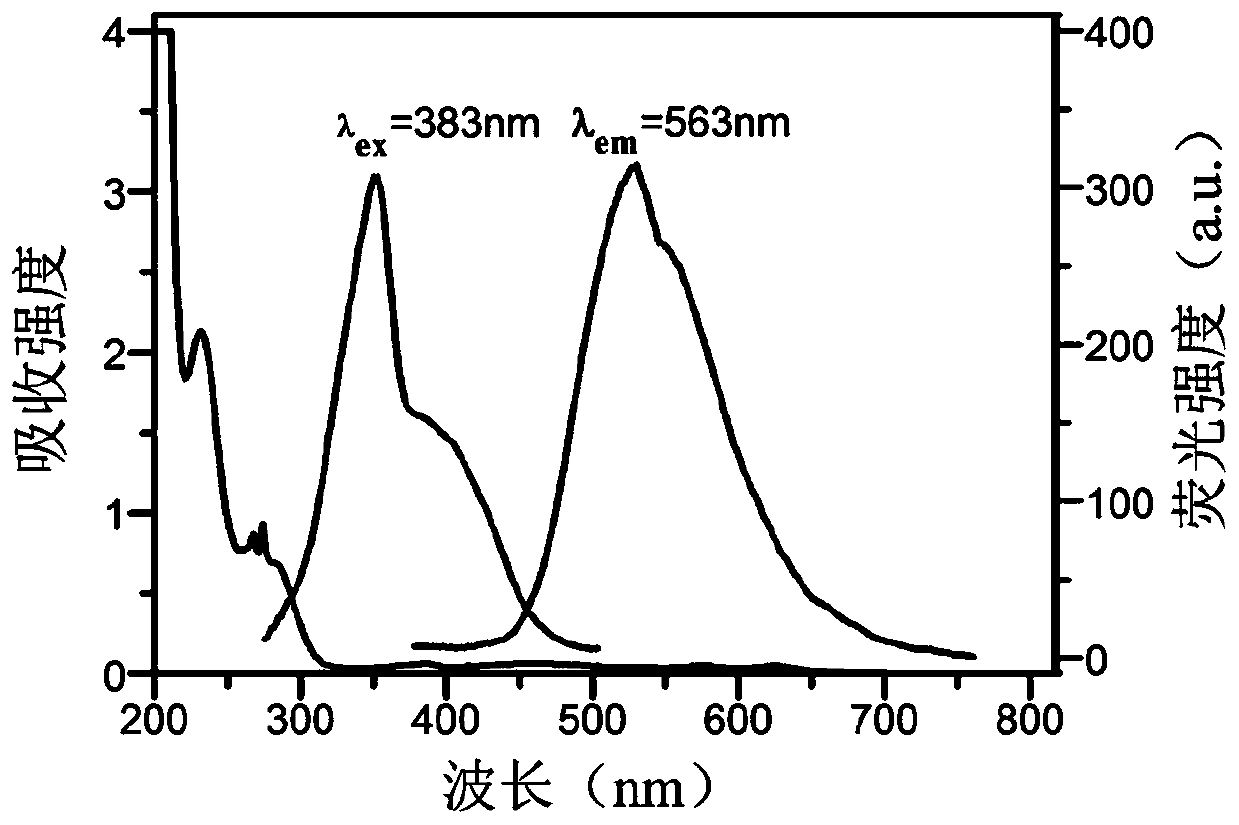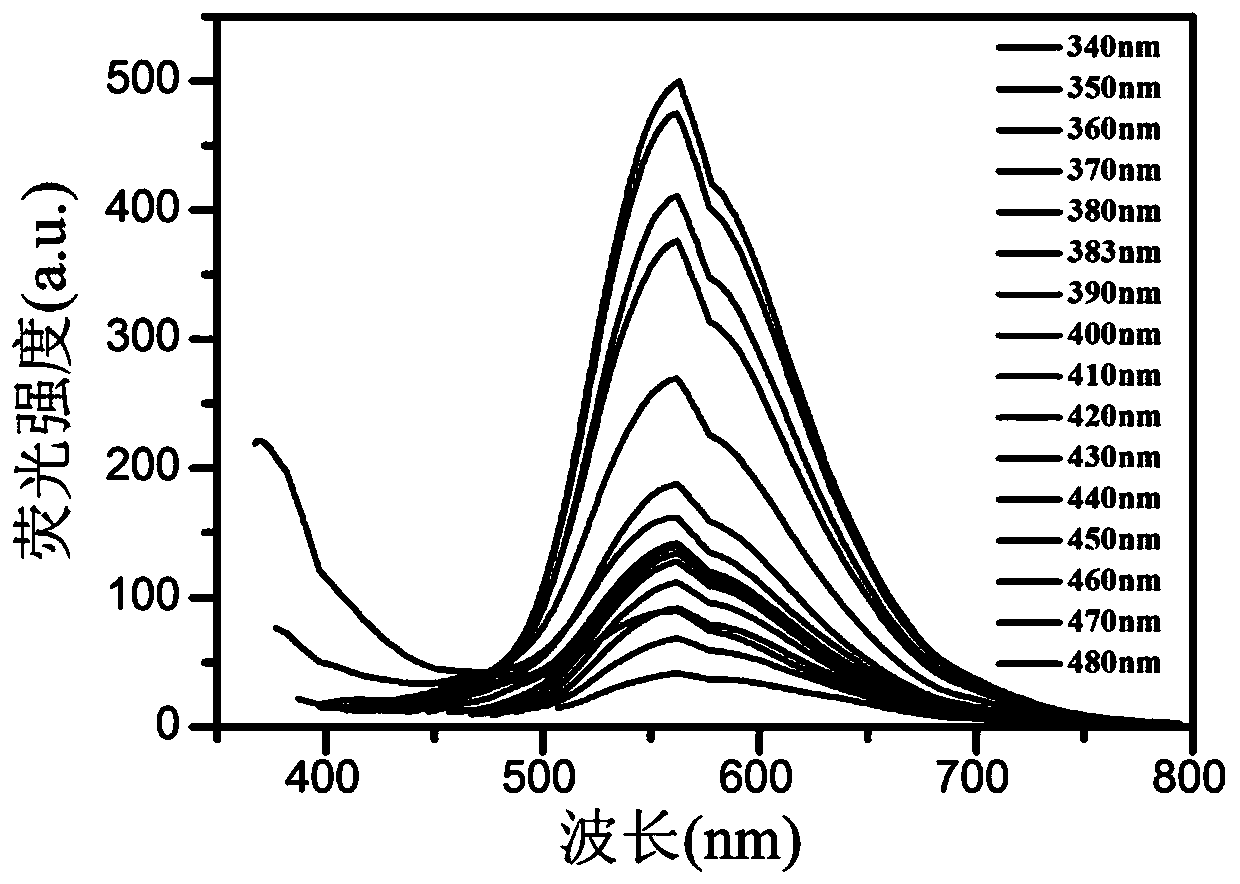Fluorescent carbon quantum dots for monitoring pH of acid environment and preparation method and application of fluorescent carbon quantum dots
A technology of carbon quantum dots and fluorescence, applied in the field of luminescent nanomaterials, can solve the problems of weak penetration ability of carbon dots, limited application, photodamage of biological tissues and side effects, and achieve good water solubility and biocompatibility, preparation method easy effect
- Summary
- Abstract
- Description
- Claims
- Application Information
AI Technical Summary
Problems solved by technology
Method used
Image
Examples
Embodiment 1
[0029] Preparation method of carbon dots:
[0030] (1) Take 0.108g of o-phenylenediamine and 0.173g of p-aminobenzenesulfonic acid respectively in a container, add 20mL of absolute ethanol, stir thoroughly and ultrasonically dissolve for 20 minutes;
[0031] (2) Transfer the above to a hydrothermal reaction kettle, place it in an oven, and react at 200°C for 8 hours;
[0032] (3) After the reaction stops, let it stand and cool to room temperature, filter, centrifuge at 8000r / m for 15min, remove insoluble matter to obtain a dark blue solution, and filter with a 0.22 μm filter membrane to obtain a pure aqueous solution of carbon dots;
[0033] (4) The target product was obtained after the above-mentioned carbon dot aqueous solution was vacuum-dried, and its relative quantum yield (based on quinine sulfate) was 15.97%;
[0034] The obtained carbon quantum dots were respectively dissolved in PBS buffer solutions of pH=7.0, pH=3.0 and pH=1.5 to form a solution of 0.4 mg / ml, which ...
Embodiment 2
[0041] (1) Take 0.108g of o-phenylenediamine and 0.087g of p-aminobenzenesulfonic acid respectively in a container, add 20mL of absolute ethanol, stir thoroughly and ultrasonically dissolve for 20 minutes;
[0042] (2) Transfer the above to a hydrothermal reaction kettle, place it in an oven, and react at 200°C for 8 hours;
[0043] (3) After the reaction stops, let it stand and cool to room temperature, filter, centrifuge at 8000r / m for 15min, remove insoluble matter to obtain a dark blue solution, and filter with a 0.22 μm filter membrane to obtain a pure aqueous solution of carbon dots;
[0044] (4) The target product was obtained after vacuum-drying the above carbon dot aqueous solution, and its relative quantum yield (based on quinine sulfate) was 9.93%.
Embodiment 3
[0046](1) Take 0.108g of o-phenylenediamine and 0.087g of p-aminobenzenesulfonic acid respectively in a container, add 10mL of absolute ethanol, stir thoroughly and ultrasonically dissolve for 20 minutes;
[0047] (2) Transfer the above to a hydrothermal reaction kettle, and place it in an oven, and react at 180°C for 10 hours;
[0048] (3) After the reaction stops, let it stand and cool to room temperature, filter, centrifuge at 8000r / m for 15min, remove insoluble matter to obtain a dark blue solution, and filter with a 0.22 μm filter membrane to obtain a pure aqueous solution of carbon dots;
[0049] (4) The target product was obtained after vacuum-drying the above carbon dot aqueous solution, and its relative quantum yield (based on quinine sulfate) was 8.08%.
PUM
| Property | Measurement | Unit |
|---|---|---|
| Particle size | aaaaa | aaaaa |
Abstract
Description
Claims
Application Information
 Login to View More
Login to View More - R&D Engineer
- R&D Manager
- IP Professional
- Industry Leading Data Capabilities
- Powerful AI technology
- Patent DNA Extraction
Browse by: Latest US Patents, China's latest patents, Technical Efficacy Thesaurus, Application Domain, Technology Topic, Popular Technical Reports.
© 2024 PatSnap. All rights reserved.Legal|Privacy policy|Modern Slavery Act Transparency Statement|Sitemap|About US| Contact US: help@patsnap.com










